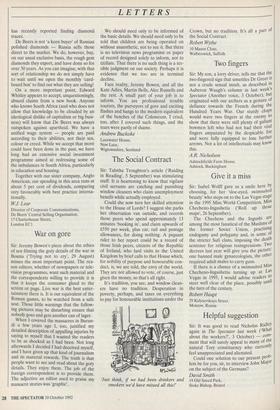On the other hand
Sir: You will not expect De Beers to agree with Edward Whitley's contention that 'the bottom is dropping out of the diamond market' (Tailing like a stone', 19 Septem- ber). In fact all is not doom and gloom. Retail sales, while not at their peak, have held up fairly well in the recession. Ameri- ca and Japan between them account for about 60 per cent of world sales by value. Internationally, diamonds continue to be desired for their beauty and symbolic value, and as a store of value.
One reason why diamonds have a stable rather than a volatile price is that all the major producers — Russia, Botswana, South Africa, Namibia, Australia, Angola and Zaire — sell their diamonds through De Beers' Central Selling Organisation. This system of centralised marketing has existed for over 60 years.
While it is not 'unimaginably wealthy', De Beers has deliberately built up over the years a portfolio of investments outside the diamond industry to give us the financial strength to carry both working stocks and extra buffer stocks in times of economic recession.
When demand is down, or a new mine comes on stream, rough diamonds in excess of current market demand (usually specific sizes or qualities) are held in a buffer stock, to be released on to the market when demand improves. But all diamonds are sold through to the market over the busi- ness cycle; there is no permanent stock overhang. There are a number of errors in Edward Whitley's article — too many really some of which are worth correcting, and one charge to which we take serious excep- tion.
De Beers' long- and medium-term liabili- ties at the end of last year were $1.2 billion, not $2 billion. The article did not, though, mention our healthy cash balances of $759 million or our $5 billion-plus portfolio of investments outside the diamond industry.
To put our diamond stocks into perspec- tive: at the end of 1991 they were just over $3 billion, equivalent to about three quar- ters of that year's sales. In the last recession they reached over one and a third times 1982 sales. Hardly 'a disturbing growth in unsold diamond stock'.
We use the word 'illicit' for the diamonds smuggled out of Angola because they are stolen by often armed and unauthorised diggers and neither the State nor the legiti- mate diamond mining companies receive any revenue. Furthermore, future mining prospects are damaged. The Angolan gov- ernment is very conscious that precious assets are being squandered.
The price of a one-carat D flawless dia- mond may have reached $16,000 in 1986 about today's price — but not $90,000! Where on earth do figures like that come from?
There has been no massive find in Cana- da which will 'dwarf the South African mines', though one prospecting company has recently reported finding diamond traces.
De Beers is not 'a keen buyer' of Russian polished diamonds — Russia sells those direct to the market. We do, however, buy, on our usual exclusive basis, the rough gem diamonds they export, and have done so for over 30 years. As you can imagine, with that sort of relationship we do not simply have to wait until we open the monthly 'card- board box' to find out what they are selling!
On a more important point, Edward Whitley appears to accept, unquestioningly, absurd claims from a new book. Anyone who knows South Africa (and who does not allow that knowledge to be clouded by an ideological dislike of capitalism or big busi- ness) will know that De Beers was always outspoken against apartheid. We have a unified wage system — people are paid according to their abilities, not their sex, colour or creed. While we accept that more could have been done in the past, we have long had an extensive social investment programme aimed at redressing some of the imbalances in South Africa, particularly in education and housing.
Together with our sister company, Anglo American, our spending in this area runs at about 5 per cent of dividends, comparing very favourably with best practice interna- tionally.
W.J. Lear
Director of Corporate Communications, De Beers' Central Selling Organisation, 17 Charterhouse Street, London EC1



























































 Previous page
Previous page